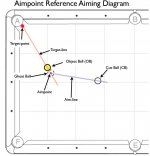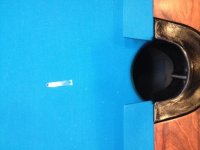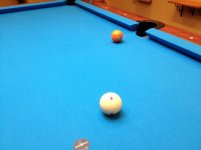Here is another aiming system I refer to as the aimpoint reference system. The purpose of the thread is to provide a reference tool that enables people to find the aimpoint more reliably.
First, I’m not claiming that it’s new. It’s based on the ghost ball method and has been discussed by others before in many similar ways. Using an aimpoint at the base of the ghost ball has been around for a while.
Second, I don’t believe it’s the ‘best’ system as there are too many examples of top players using many varied systems that work quite well for them. There is no ‘best’ system, although for many reasons I believe an aimpoint system is superior to many systems, however, it’s up to the individual user to find which system works well for them.
The main purpose of this is thread is to show people another simple tool that enables them to find the aimpoint reference more reliably for a variety of different shots on the table (photos in next post).
The image below shows the basic components of the aimpoint reference system. Each component is important to understand and use the aimpoint system. Normally I don’t show all of these components at once but for brevity did so for the AZB forum.
I’ve never been able to ‘see’ the ghost ball so I had to figure something else out. The next post shows the aimpoint tool used to ‘see’ where the aimpoint is.
For those that want to lecture about how a ghost ball method doesn’t deal with throw, squirt, or swerve, etc… No method deals with these issues and I believe they are best dealt with by experience and feel. The aimpoint method provides a solid base to work from. Experience and practice will provide the final key components needed to round out any aiming system which in the end I believe depends a great deal on learning what it feels like when the shot is 'on'.
First, I’m not claiming that it’s new. It’s based on the ghost ball method and has been discussed by others before in many similar ways. Using an aimpoint at the base of the ghost ball has been around for a while.
Second, I don’t believe it’s the ‘best’ system as there are too many examples of top players using many varied systems that work quite well for them. There is no ‘best’ system, although for many reasons I believe an aimpoint system is superior to many systems, however, it’s up to the individual user to find which system works well for them.
The main purpose of this is thread is to show people another simple tool that enables them to find the aimpoint reference more reliably for a variety of different shots on the table (photos in next post).
The image below shows the basic components of the aimpoint reference system. Each component is important to understand and use the aimpoint system. Normally I don’t show all of these components at once but for brevity did so for the AZB forum.
I’ve never been able to ‘see’ the ghost ball so I had to figure something else out. The next post shows the aimpoint tool used to ‘see’ where the aimpoint is.
For those that want to lecture about how a ghost ball method doesn’t deal with throw, squirt, or swerve, etc… No method deals with these issues and I believe they are best dealt with by experience and feel. The aimpoint method provides a solid base to work from. Experience and practice will provide the final key components needed to round out any aiming system which in the end I believe depends a great deal on learning what it feels like when the shot is 'on'.


